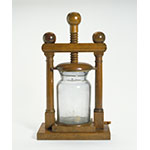Thick-walled glass vessel housed in a wooden frame. A large screw holds a wooden cap on the vessel. Such devices were typically used to demonstrate phenomena due to air compression. This particular vessel, however, was used to prepare chlorine gas from a reaction involving manganese dioxide, common salt, and sulfuric acid. The gas was kept under moderate pressure. When the screw was loosened, the cover rose and the chlorine escaped into the room, disinfecting it. The operation could be repeated several times without having to "recharge" the vessel. This disinfection system, invented by Guyton de Morveau in the early nineteenth century, was widely used in hospitals between c. 1805 and 1820. A similar instrument was built by the instrument-maker Dumotiez and the pharmacist Boullay, about whom we have little information. Provenance: Lorraine collections.










